Video Introduction: Cancer Biology, AP Bio Level
Start by learning the connection between cell cycle checkpoints, mutation, and signal transduction systems by watching the video below.
1. What is Cancer?
Cancer is a disease involving uncontrolled cell growth. In 2018, it was the second leading cause of death worldwide.
Cancer comes about when cells acquire mutations that increase their rate of replication. Instead of acting as team players that follow the rules that would make them contributing members of their body tissue or organ, cancer cells start to divide on their own.
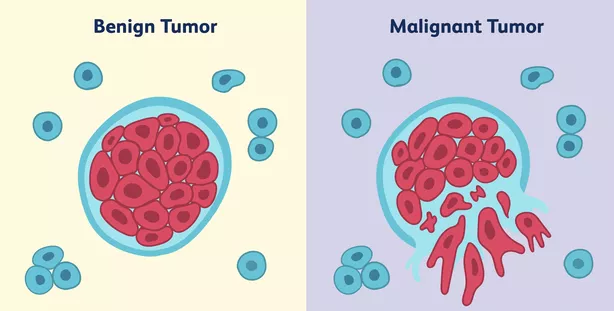
When cells grow abnormally in their site of origin, they form an unorganized mass of cells called a tumor. If the cells in a tumor remain where they started, the tumor is considered to be benign. Benign tumors can usually be removed through surgery. Cancer occurs when the cells in a tumor acquire additional mutations that enable them to leave their site of origin, spreading tumors throughout the body. This process is called metastasis. A metastatic tumor is said to be malignant.
Once cancer has metastasized throughout the body, it’s much more difficult to treat. Click the following link to learn more about metastatic cancer and options for treating it.
Cancer cells have a variety of features that distinguish them from normal cells, six of which are illustrated below.
Cancer cells:
- Don’t need external signals to divide. This is in contrast to the highly organized cells in any body tissue, which only divide when they receive signals that tell them to divide.
- Evade or ignore internal and external signals telling them to self-destruct. This process, called programmed cell death or apoptosis, is part of normal growth and development (and we’ll explore it in more detail below).
- Can divide indefinitely. This is in contrast to normal cells, which are limited in terms of how many times they can divide (usually about 20 to 50 times). This makes cancer cells, relative to normal cells, immortal (though the cancer cells will die when they kill the organism where they’re growing). If these cancer cells are removed from the body and grown in tissue culture, they can truly be immortal and outlive the person who gave rise to them. An immortal cell line from cancer victim Henrietta Lacks, who died of cervical cancer in 1951, has become a key tool in cell biology investigation. You can learn more about these cells here and in Rebecca Skloot’s remarkable book The Immortal Life of Henrietta Lacks.
- Ignore signals telling cells not to divide. Normal tissue cells receive signals that say “you’re doing your job: don’t replicate.” Cancer cells receive these signals but ignore them.
- Can spread from their site of origin and invade other organs and tissues. This is known as metastasis and was described above.
- Can induce nearby blood vessels to grow in their direction, supplying growing tumors with oxygen and nutrients. This process is called angiogenesis.

- Six characteristics of cancer. Created with Biorender.com
In addition, cancer cells
- Process nutrients differently from other cells, often favoring an accelerated form of glycolysis over aerobic metabolism.
- Often have abnormal chromosomal patterns. That includes abnormal chromosome numbers, broken chromosomes, and chromosomes that are fused together.
- Evade detection and destruction by the immune system.
- Are associated with chronic inflammation, which can cause cells to become cancerous, and also assist cancer’s spread.
Below, we’ll learn about the kind of genetic changes that lead cells to become cancerous. But first, take the quiz below.
2. What is Cancer? Checking Understanding
[qwiz qrecord_id=”sciencemusicvideosMeister1961-What is Cancer (v2.0)” dataset=”What is Cancer?”]
[h] What is Cancer: Checking Understanding
[i]
[q json=”true” dataset_id=”What is Cancer?|e3cdfd1dbfbd3″ question_number=”1″] If tumor “A” stays in its current location, it can be considered to be [hangman]. By contrast, cells from tumor “B” are leaving their site of origin. That process is called [hangman], and the tumor would be classified as being [hangman].
[c]IGJlbmlnbg==[Qq]
[f]IEV4Y2VsbGVudCE=[Qq]
[c]IG1ldGFzdGFzaXM=[Qq]
[f]IEV4Y2VsbGVudCE=[Qq]
[c]IG1hbGlnbmFudC4=[Qq]
[f]IEdvb2Qh[Qq]
[q json=”true” dataset_id=”What is Cancer?|e3cd681ac6bd3″ question_number=”2″] In the diagram below, which number shows a cell undergoing programmed cell death, or apoptosis?
[textentry single_char=”true”]
[c]ID I=[Qq]
[f]IEV4Y2VsbGVudCEgJiM4MjIwOzImIzgyMjE7IHNob3dzIGEgY2VsbCB1bmRlcmdvaW5nIGFwb3B0b3Npcy4=[Qq]
[c]ICo=[Qq]
[f]IE5vLiBBcG9wdG9zaXMgaXMgcHJvZ3JhbW1lZCBjZWxsIGRlYXRoLiBTdHVkeSB0aGUgZGlhZ3JhbSwgYW5kIHNlZSB3aGljaCBpbWFnZSBzaG93cyBhIGNlbGwgdGhhdCBpcyBkaXNpbnRlZ3JhdGluZy4=[Qq]
[c]IEVudGVyIGxldHRlcg==[Qq]
[q json=”true” dataset_id=”What is Cancer?|e3ccd317cdbd3″ question_number=”3″] In the diagram below, which number represents metastasis?
[textentry single_char=”true”]
[c]ID U=[Qq]
[f]IEV4Y2VsbGVudCEgJiM4MjIwOzUmIzgyMjE7IHNob3dzIGEgbWV0YXN0YXNpemluZyBjZWxsIGZyb20gYSB0dW1vciBzcHJlYWRpbmcgZnJvbSBpdHMgc2l0ZSBvZiBvcmlnaW4gYXMgaXQgZW50ZXJzIGEgYmxvb2QgdmVzc2VsLg==[Qq]
[c]ICo=[Qq]
[f]IE5vLiBIZXJlJiM4MjE3O3MgYSBoaW50IGZvciBuZXh0IHRpbWUuIFdoaWNoIGltYWdlIHNob3dzIGEgY2VsbCBmcm9tIGEgdHVtb3Igc3ByZWFkaW5nIGZyb20gaXRzIHNpdGUgb2Ygb3JpZ2luIGJ5IGVudGVyaW5nIGEgYmxvb2QgdmVzc2VsICh3aGljaCBpcyB0aGUgZXNzZW5jZSBvZiBtZXRhc3Rhc2lzKT8=[Qq]
[q json=”true” dataset_id=”What is Cancer?|e3cc18d4167d3″ question_number=”4″] In the diagram below, which number represents angiogenesis?
[textentry single_char=”true”]
[c]ID Y=[Qq]
[f]IEV4Y2VsbGVudCEgJiM4MjIwOzYmIzgyMjE7IHNob3dzIGEgdHVtb3IgdGhhdCYjODIxNztzIGluZHVjaW5nIGEgbmV3IGJsb29kIHN1cHBseS4gVGhhdCYjODIxNztzIGFuZ2lvZ2VuZXNpcy4=[Qq]
[c]ICo=[Qq]
[f]IE5vLiBIZXJlJiM4MjE3O3MgYSBoaW50IGZvciBuZXh0IHRpbWUuIEFuZ2lvZ2VuZXNpcyBpcyB3aGVuIGEgdHVtb3IgaW5kdWNlcyBuZWFyYnkgYmxvb2QgdmVzc2VscyB0byBzdXBwbHkgaXQgd2l0aCBibG9vZCBieSBncm93aW5nIG5ldyBibG9vZCB2ZXNzZWxzLg==[Qq]
[q json=”true” dataset_id=”What is Cancer?|e3cb83d11d7d3″ question_number=”5″]Cancer cells don’t need external signals to [hangman]. They also evade internal and external signals to self-[hangman], a process called programmed cell death or [hangman].
[c]ZGl2aWRl[Qq]
[c]ZGVzdHJ1Y3Q=[Qq]
[c]YXBvcHRvc2lz[Qq]
[q json=”true” dataset_id=”What is Cancer?|e3caeece247d3″ question_number=”6″]Normal cells can usually divide about 20 to 50 times before they become unable to reproduce themselves. By contrast, cancer cells can divide [hangman].
[c]aW5kZWZpbml0ZWx5[Qq]
[q json=”true” dataset_id=”What is Cancer?|e3ca348a6d3d3″ question_number=”7″]Cancer cells metabolize sugar differently from normal cells, often favoring [hangman] over aerobic metabolism. In addition, many tumors develop ways to avoid destruction by the [hangman] system.
[c]Z2x5Y29seXNpcw==[Qq]
[c]aW1tdW5l[Qq]
[x][restart]
[/qwiz]
3. Two Types of Genes are Associated with Cancer: Oncogenes and Tumor Suppressor Genes
To understand the mutations that are associated with cancer, let’s reconsider the cell cycle and its checkpoints.
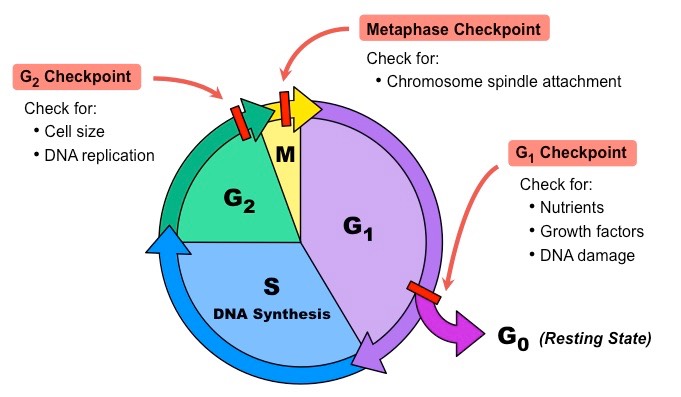
As a dividing cell progresses through the cell cycle, a variety of molecules, both internal and external to the cell, either pause the cell’s progress or encourage it to move forward.
- Genes that produce proteins that pause the cell cycle are called tumor suppressor genes. These proteins are often checkpoint proteins or DNA repair proteins.
- Genes that produce proteins that encourage the cell to move through the cell cycle are called proto-oncogenes. Examples of these proteins are cyclins, growth factors, or growth factor receptors.
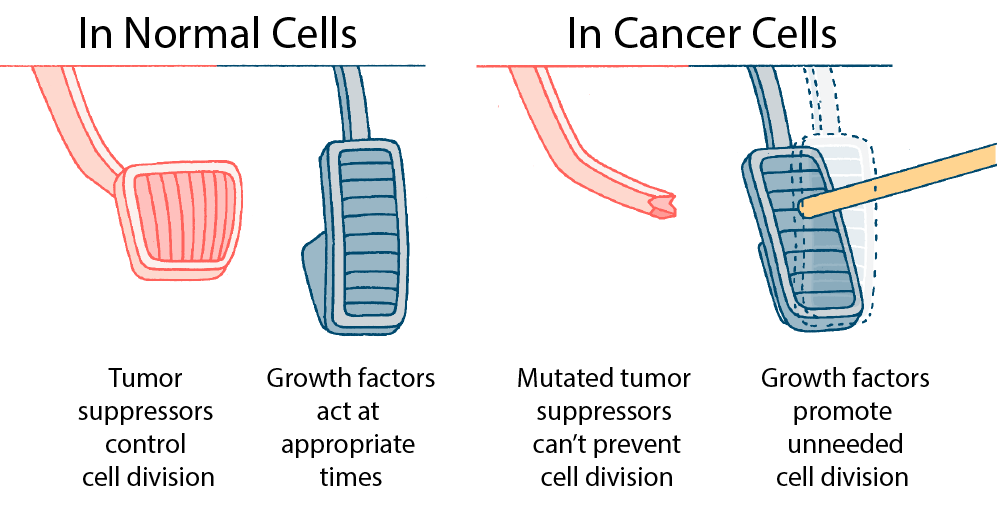 A useful and widely-used analogy is to compare a cell’s tumor suppressor genes to a car’s brake pedal, and oncogenes to a car’s accelerator (gas pedal). In a normal, noncancerous cell, a tumor suppressor protein acts as a molecular brake pedal, slowing down or pausing the cell cycle. A proto-oncogene acts like a gas pedal, enabling the cell to move forward through the cell cycle.
A useful and widely-used analogy is to compare a cell’s tumor suppressor genes to a car’s brake pedal, and oncogenes to a car’s accelerator (gas pedal). In a normal, noncancerous cell, a tumor suppressor protein acts as a molecular brake pedal, slowing down or pausing the cell cycle. A proto-oncogene acts like a gas pedal, enabling the cell to move forward through the cell cycle.
Following this model, cells can become cancerous in several ways:
- Tumor suppressor genes can mutate so that the proteins they produce no longer pause or halt the cell cycle. It’s as if the car’s brakes are defective and there’s no way to stop the car from moving forward.
- Proto-oncogenes can mutate so that the proteins they produce promote cell division, even when that’s not needed by the tissue or organ where that cell is found. It’s as if the accelerator is jammed, forcing the car to move forward. Mutated proto-oncogenes are called oncogenes.
These two ways are not mutually exclusive. It’s widely thought that cancer involves multiple mutations, which might involve both tumor suppressors and oncogenes.
4. Checking Understanding: Oncogenes and Tumor Suppressor Genes
[qwiz qrecord_id=”sciencemusicvideosMeister1961-Oncogenes and Tumor Suppressor Genes (v2.0)” dataset=”Oncogenes and Tumor Suppressor Genes”]
[h] Oncogenes and Tumor Suppressor Genes
[i]
[q json=”true” dataset_id=”Oncogenes and Tumor Suppressor Genes|e3c8c002febd3″ question_number=”1″] A normally functioning gene that promotes cell division is a [hangman]-[hangman].
[c]IHByb3Rv[Qq]
[f]IEV4Y2VsbGVudCE=[Qq]
[c]IG9uY29nZW5l[Qq]
[f]IEdvb2Qh[Qq]
[q json=”true” dataset_id=”Oncogenes and Tumor Suppressor Genes|e3c82b0005bd3″ question_number=”2″] A mutated version of a cell-division-promoting gene that produces a product that leads to accelerated cell division is called a(n) [hangman].
[c]IG9uY29nZW5l[Qq]
[f]IEV4Y2VsbGVudCE=[Qq]
[q json=”true” dataset_id=”Oncogenes and Tumor Suppressor Genes|e3c770bc4e7d3″ question_number=”3″] In the diagram below, which letter represents a mutated tumor suppressor gene?
[textentry single_char=”true”]
[c]IE M=[Qq]
[f]IEV4Y2VsbGVudCEgJiM4MjIwO0MmIzgyMjE7IHJlcHJlc2VudHMgYSBicm9rZW4gYnJha2UgcGVkYWwsIHdoaWNoIHdvdWxkIGNvcnJlc3BvbmQgdG8gYSBtdXRhdGVkIHR1bW9yIHN1cHByZXNzb3IgZ2VuZSwgbm8gbG9uZ2VyIGFibGUgdG8gcGF1c2Ugb3Igc3RvcCBjZWxsIGRpdmlzaW9uLg==[Qq]
[c]ICo=[Qq]
[f]IE5vLiBIZXJlJiM4MjE3O3MgYSBoaW50LiBJZiBhIGNlbGwgd2VyZSBsaWtlIGEgY2FyLCBhIG11dGF0ZWQgdHVtb3Igc3VwcHJlc3NvciBnZW5lIHdvdWxkIGJlIGxpa2UgYSBjYXIgdGhhdCBjb3VsZG4mIzgyMTc7dCBzdG9wIGl0c2VsZiBiZWNhdXNlIGl0cyBicmFrZXMgd2VyZSBkYW1hZ2VkLg==[Qq]
[q json=”true” dataset_id=”Oncogenes and Tumor Suppressor Genes|e3c6b678973d3″ question_number=”4″] In the diagram below, which letter represents a proto-oncogene?
[textentry single_char=”true”]
[c]IE I=[Qq]
[f]IE5pY2UhICYjODIyMDtCJiM4MjIxOyByZXByZXNlbnRzIGEgZnVuY3Rpb25pbmcgYWNjZWxlcmF0b3IsIHdoaWNoIGNvcnJlc3BvbmRzIHRvIGEgcHJvdG8tb25jb2dlbmU6IGEgZ2VuZSB0aGF0IG1ha2VzIGEgcHJvZHVjdCB0aGF0IHByb21vdGVzIGNlbGwgZGl2aXNpb24u[Qq]
[c]ICo=[Qq]
[f]IE5vLiBIZXJlJiM4MjE3O3MgYSBoaW50LiBJZiBhIGNlbGwgd2VyZSBsaWtlIGEgY2FyLCBhIHByb3RvLW9uY29nZW5lIHdvdWxkIGFwcHJvcHJpYXRlbHkgbW92ZSB0aGUgY2FyIGZvcndhcmQgdGhyb3VnaCB0aGUgY2VsbCBjeWNsZS4=[Qq]
[q json=”true” dataset_id=”Oncogenes and Tumor Suppressor Genes|e3c621759e3d3″ question_number=”5″] In the diagram below, which letter represents an oncogene?
[textentry single_char=”true”]
[c]IE Q=[Qq]
[f]IEF3ZXNvbWUhICYjODIyMDtEJiM4MjIxOyByZXByZXNlbnRzIGFuIGFjY2VsZXJhdG9yIHRoYXQmIzgyMTc7cyBiZWVuIGZvcmNlZCBkb3duLCB3aGljaCBjb3JyZXNwb25kcyB0byBhbiBvbmNvZ2VuZTogYSBnZW5lIHRoYXQgcHJvbW90ZXMgY2VsbCBkaXZpc2lvbiBldmVuIHdoZW4gdGhhdCYjODIxNztzIG5vdCBzb21ldGhpbmcgdGhlIGJvZHkgbmVlZHMu[Qq]
[c]ICo=[Qq]
[f]IE5vLiBIZXJlJiM4MjE3O3MgYSBoaW50LiBJZiBhIGNlbGwgd2VyZSBsaWtlIGEgY2FyLCBhbiBvbmNvZ2VuZSB3b3VsZCBwcm9tb3RlIGFjY2VsZXJhdGlvbiwgZXZlbiBpZiB0aGF0IHdvdWxkIHdyZWNrIHRoZSBjYXIu[Qq]
[q json=”true” dataset_id=”Oncogenes and Tumor Suppressor Genes|e3c56731e6fd3″ question_number=”6″]A gene that codes for a protein that plays a role in a cell cycle checkpoint would most likely be a [hangman] [hangman] gene.
[c]dHVtb3I=[Qq]
[c]c3VwcHJlc3Nvcg==[Qq]
[q json=”true” dataset_id=”Oncogenes and Tumor Suppressor Genes|e3c3132602fd3″ question_number=”7″]A gene that codes for a [hangman] that encourages the cell to progress through the cell cycle (such as cyclin or a cyclin-dependent kinase) would be classified as a [hangman]-[hangman] gene.
[c]cHJvdGVpbg==[Qq]
[c]cHJvdG8=[Qq]
[c]b25jb2dlbmU=[Qq]
[/qwiz]
5. Oncogenes, Tumor Suppressor Genes, and Signal Transduction Pathways
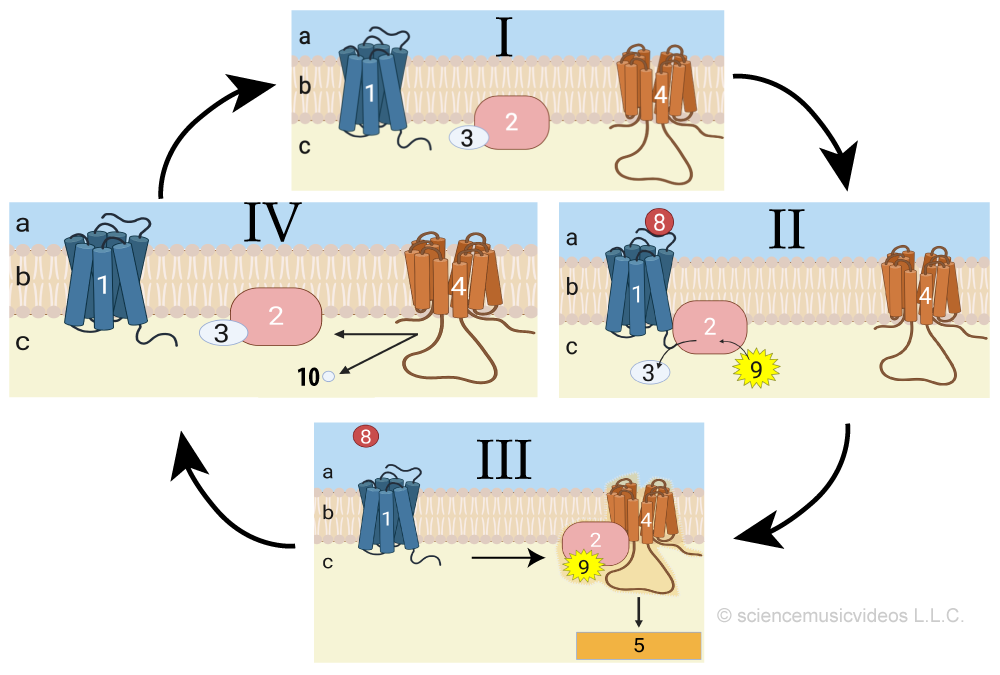 5a. Oncogenes
5a. Oncogenes
Here’s how a mutation in an oncogene could disrupt a signal transduction pathway in a way that could cause cancer.
Let’s start with a quick review of signaling systems. In diagram I on the right, the G protein (2) is inactive, bound to GDP (3). Diagram II shows how when a ligand (8) binds with a G-protein coupled receptor (1) the G protein becomes active and binds with GTP (9). That enables the G protein to bind with adenylyl cyclase (4), which converts ATP into cAMP (not shown), initiating a phosphorylation cascade (also not shown), eliciting a cellular response (5).
RAS is a gene that codes for a G protein (also called RAS). Mutations in RAS genes are associated with about a third of all human cancers, including cancers of the lungs, pancreas, and colon.
In its normal form, RAS is a proto-oncogene, and the RAS protein codes for molecules that encourage the cell to progress through the cell cycle.
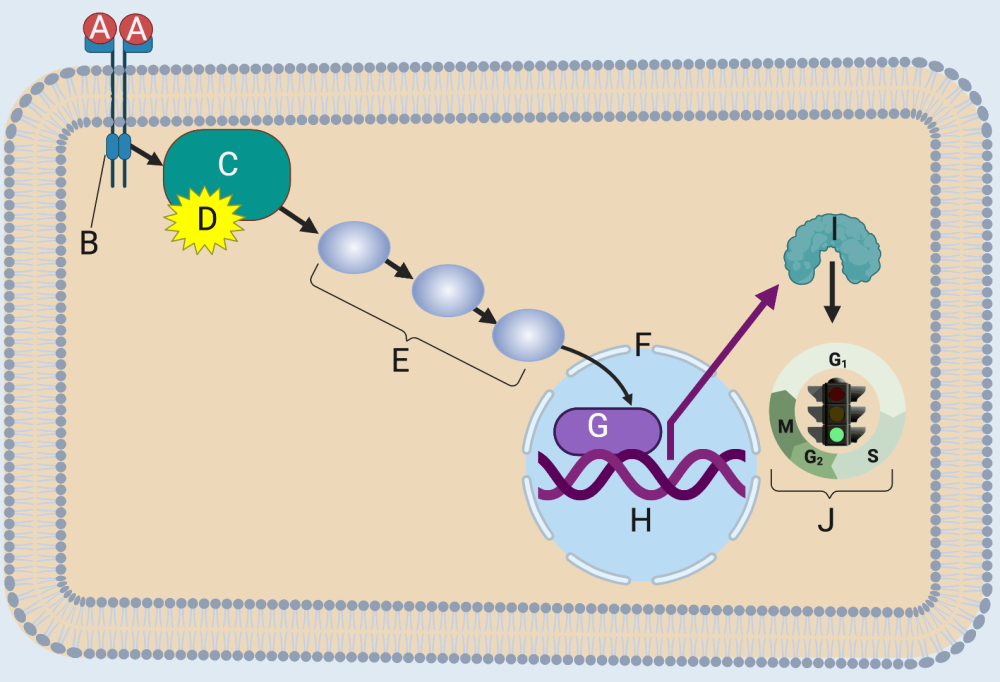
Here’s how RAS functions as a non-cancer-causing proto-oncogene. When a ligand (A) binds with its receptor (B), RAS (C) binds with GTP (D). In this activated form, RAS can initiate a phosphorylation cascade (E) that ends with a transcription factor (G) entering the nucleus (F).
Transcription factors are exactly what they sound like: they bind with genes (H) and cause the DNA to be transcribed into RNA (not shown), which gets translated into a protein (I). In this case, the protein stimulates the cell cycle (J).
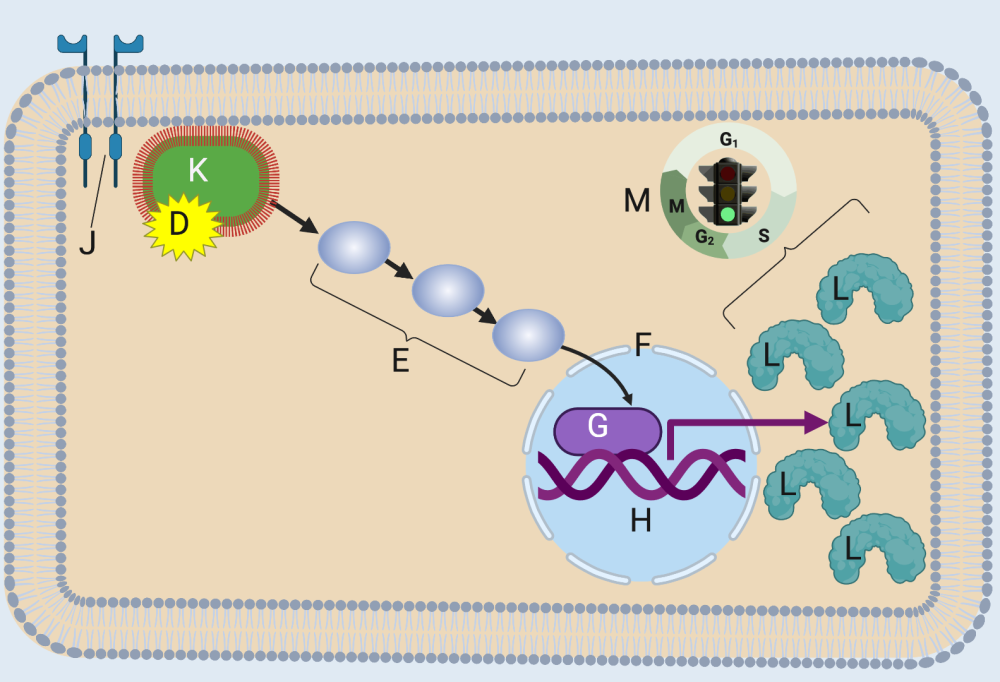
A mutation in RAS causes the RAS G-protein to be constitutively active. “Constitutively active” means that RAS is always in its “on” condition, bound to GTP. You can see this in the image on the right. The mutant RAS protein (K) binds to GTP (D), even though there’s no cell-division-inducing ligand bound to its receptor (J).
Because this mutant RAS is constitutively bound to GTP, it can activate the same phosphorylation cascade, leading to the transcription of its target gene. And because RAS is always “on,” the cell winds up producing too much of its target protein (L), which overstimulates the cell to divide (M).
Oncogenes can also involve the overexpression of receptors. One such receptor is HER2 (human epidermal growth factor receptor 2), which is overexpressed in about 25% of breast cancers.

“Overexpression” means that the cell produces too much of a gene product. In this case, the overexpressed gene codes for the HER2 receptor. With too many receptors, the cell becomes oversensitized to epidermal growth factor, a protein that stimulates mitosis. As a result, cells with this mutation divide when they shouldn’t, potentially leading to cancer.
5b. Tumor Suppressor Genes
The p53 gene is a tumor suppressor gene. It produces a protein that is found inside the nucleus, and which plays several roles that protect the body from cancer. These include:
- Activating DNA-repair proteins in response to DNA damage.
- Pausing the cell cycle at the G1 checkpoint so that DNA repair has time to occur. This prevents cells with mutations from reproducing.
- Initiating apoptosis (programmed cell death) when DNA can’t be repaired.
p53 is so important that it’s called the “Guardian of the Genome.”
Here’s how it works
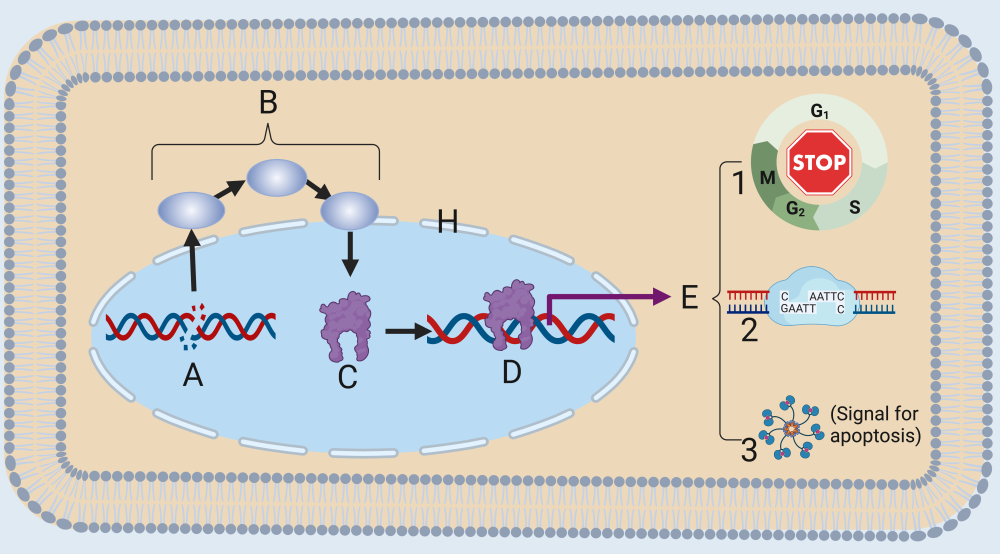
Letter “A” shows DNA damage. This could occur from an error during DNA replication or from a mutation-causing agent such as ultraviolet radiation. Through a variety of mechanisms, a cell can detect DNA damage, which initiates a signaling cascade (B). This cascade results in the activation of the p53 protein. p53, once activated, initiates transcription of a variety of genes (one of which is shown at “D”).
E shows the effects of transcription: halting the cell cycle (1), DNA repair (2), or release of signal that will cause the cell to self-destruct (3). The overall effect: preventing a cell with damaged DNA from reproducing.
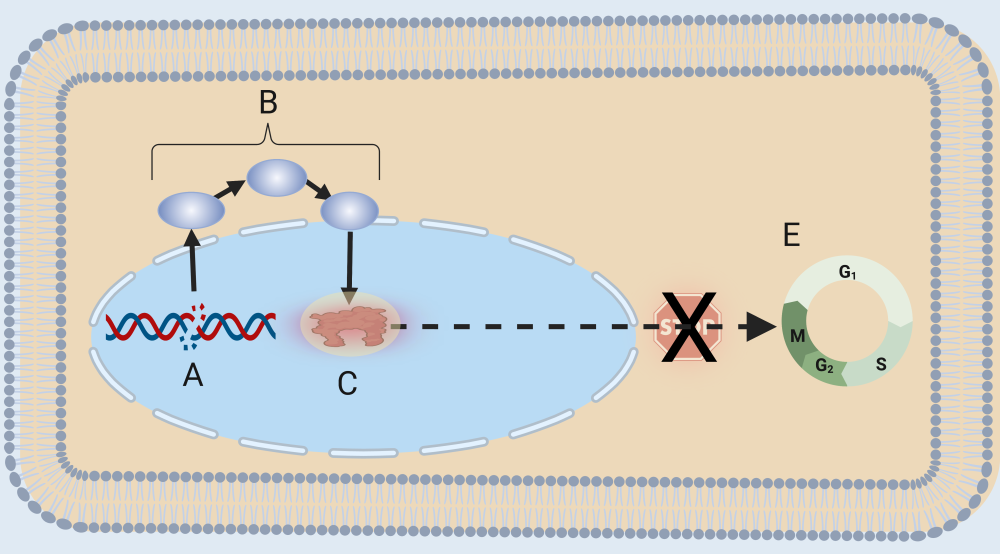 If a mutation occurs in the p53 gene, then the p53 protein (indicated by “C”) will be defective or missing. In that case, p53 will be unable to respond in a way that repairs DNA, halts the cell cycle, or destroys the cell. As a result, the cell will continue to move through the cell cycle (E) with broken or damaged DNA, increasing the chance that the cell will become cancerous.
If a mutation occurs in the p53 gene, then the p53 protein (indicated by “C”) will be defective or missing. In that case, p53 will be unable to respond in a way that repairs DNA, halts the cell cycle, or destroys the cell. As a result, the cell will continue to move through the cell cycle (E) with broken or damaged DNA, increasing the chance that the cell will become cancerous.
6. Cancer and Signal Transduction: Checking Understanding
[qwiz qrecord_id=”sciencemusicvideosMeister1961-Cancer and Signal Transduction (v2.0)” dataset=”Cancer and Signal Transduction”]
[h]Cancer and Signal Transduction: Checking Understanding
[i]
[q json=”true” dataset_id=”Cancer and Signal Transduction|e3c19e9e947d3″ question_number=”1″] In the diagram below, which letter represents a ligand that’s inducing the production of molecules that lead to cell division?
[textentry single_char=”true”]
[c]IE E=[Qq]
[f]IEF3ZXNvbWUhICYjODIyMDtBJiM4MjIxOyByZXByZXNlbnRzIGEgbGlnYW5kIHRoYXQmIzgyMTc7cyBiaW5kaW5nIHdpdGggYSByZWNlcHRvciwgYWN0aXZhdGluZyBSQVMsIGxlYWRpbmcgdG8gdGhlIHByb2R1Y3Rpb24gb2YgYSBtb2xlY3VsZSB0aGF0IHdpbGwgc3RpbXVsYXRlIHRoZSBjZWxsIGN5Y2xlLg==[Qq]
[c]ICo=[Qq]
[f]IE5vLiBIZXJlJiM4MjE3O3MgYSBoaW50LiBBIGxpZ2FuZCBiaW5kcyB3aXRoIGEgcmVjZXB0b3Iu[Qq]
[q json=”true” dataset_id=”Cancer and Signal Transduction|e3c1099b9b7d3″ question_number=”2″]In the diagram below, which letter represents a phosphorylation cascade that leads to cell division?
[textentry single_char=”true”]
[c]IE U=[Qq]
[f]IEF3ZXNvbWUhICYjODIyMDtFJiM4MjIxOyByZXByZXNlbnRzIGEgcGhvc3Bob3J5bGF0aW9uIGNhc2NhZGUu[Qq]
[c]ICo=[Qq]
[f]IE5vLiBIZXJlJiM4MjE3O3MgYSBoaW50LiBGaW5kIGEgc2VyaWVzIG9mIGNoZW1pY2FsIHNpZ25hbHMgdGhhdCBsZWFkcyBhIG1lc3NhZ2UgdG8gZW50ZXIgdGhlIG51Y2xldXMu[Qq]
[q json=”true” dataset_id=”Cancer and Signal Transduction|e3c07498a27d3″ question_number=”3″]The diagram below shows how a [hangman] RAS, coded for by an [hangman] is producing a signal for the cell to [hangman], even in the absence of a growth signal (at J)
[c]bXV0YXRlZA==[Qq]
[c]b25jb2dlbmU=[Qq]
[c]ZGl2aWRl[Qq]
[q json=”true” dataset_id=”Cancer and Signal Transduction|e3bfba54eb3d3″ question_number=”4″]In the diagram below, a transcription factor is indicated by the letter
[textentry single_char=”true”]
[c]IE c=[Qq]
[f]IE5pY2UhICYjODIyMDtHJiM4MjIxOyByZXByZXNlbnRzIGEgdHJhbnNjcmlwdGlvbiBmYWN0b3Iu[Qq]
[c]ICo=[Qq]
[f]IE5vLiBIZXJlJiM4MjE3O3MgYSBoaW50LiBGaW5kIGEgbW9sZWN1bGUgdGhhdCYjODIxNztzIGludGVyYWN0aW5nIHdpdGggRE5BLCBsZWFkaW5nIHRvIHRoZSBwcm9kdWN0aW9uIG9mIGEgcHJvdGVpbiAoc3VjaCBhcyB0aGUgb25lIGF0ICYjODIyMDtMLiYjODIyMTspLg==[Qq]
[q json=”true” dataset_id=”Cancer and Signal Transduction|e3bf2551f23d3″ question_number=”5″]The diagram below is showing how [hangman] of the gene for the HER2 receptor can lead cells to reproduce too much, leading to cancer. That would make the gene for the normal receptor (found at “1”) a [hangman]-[hangman].
[c]b3ZlcmV4cHJlc3Npb24=[Qq]
[c]cHJvdG8=[Qq]
[c]b25jb2dlbmU=[Qq]
[q json=”true” dataset_id=”Cancer and Signal Transduction|e3be6b0e3afd3″ question_number=”6″]In the diagram below, which letter would represent the p53 protein?
[textentry single_char=”true”]
[c]IE M=[Qq]
[f]IEdvb2Qgd29yayEgJiM4MjIwO0MmIzgyMjE7IHJlcHJlc2VudHMgcDUzLg==[Qq]
[c]ICo=[Qq]
[f]IE5vLiBIZXJlJiM4MjE3O3MgYSBoaW50LiBGaW5kIGEgbW9sZWN1bGUgdGhhdCYjODIxNztzIHByb2R1Y2VkIGluIHJlc3BvbnNlIHRvIEROQSBkYW1hZ2UsIGFuZCB3aGljaCBoYXMgYSB2YXJpZXR5IG9mIGVmZmVjdHMgdGhhdCBwcm90ZWN0IHRoZSBjZWxsIGZyb20gY2FuY2VyLg==[Qq]
[q json=”true” dataset_id=”Cancer and Signal Transduction|e3bdb0ca83bd3″ question_number=”7″]The diagram below shows how a(n) [hangman] in the gene for the p53 protein creates a non-functioning [hangman] [hangman] that allows the cell to divide even when there’s been DNA damage.
[c]bXV0YXRpb24=[Qq]
[c]dHVtb3I=[Qq]
[c]c3VwcHJlc3Nvcg==[Qq]
[q json=”true” multiple_choice=”true” dataset_id=”Cancer and Signal Transduction|e3bc86c491bd3″ question_number=”8″]A mutated p53 gene would best be represented by which letter below?
[c]QQ==[Qq]
[f]Tm8uIEhlcmUmIzgyMTc7cyBhIGhpbnQuIHA1MyBpcyBhIHR1bW9yIHN1cHByZXNzb3IgZ2VuZS4gaXQgaW5oaWJpdHMgY2VsbCBkaXZpc2lvbi4gSW4gYSBjYXIsIHdoYXQgY291bGQgYWxsb3cgYSBjYXIgdG8gbW92ZSBmb3J3YXJkLCBldmVuIHdoZW4gaXQgc2hvdWxkbiYjODIxNzt0Pw==[Qq]
[c]Qg==[Qq]
[f]Tm8uIEhlcmUmIzgyMTc7cyBhIGhpbnQuIHA1MyBpcyBhIHR1bW9yIHN1cHByZXNzb3IgZ2VuZS4gaXQgaW5oaWJpdHMgY2VsbCBkaXZpc2lvbi4gSW4gYSBjYXIsIHdoYXQgY291bGQgYWxsb3cgYSBjYXIgdG8gbW92ZSBmb3J3YXJkLCBldmVuIHdoZW4gaXQgc2hvdWxkbiYjODIxNzt0Pw==[Qq]
[c]Qw ==[Qq]
[f]RXhjZWxsZW50LiBIZXJlJiM4MjE3O3MgYSBoaW50LiBwNTMgaXMgYSB0dW1vciBzdXBwcmVzc29yIGdlbmUuIGl0IGluaGliaXRzIGNlbGwgZGl2aXNpb24u[Qq]
[c]RA==[Qq]
[f]Tm8uIEhlcmUmIzgyMTc7cyBhIGhpbnQuIHA1MyBpcyBhIHR1bW9yIHN1cHByZXNzb3IgZ2VuZS4gaXQgaW5oaWJpdHMgY2VsbCBkaXZpc2lvbi4gSW4gYSBjYXIsIHdoYXQgY291bGQgYWxsb3cgYSBjYXIgdG8gbW92ZSBmb3J3YXJkLCBldmVuIHdoZW4gaXQgc2hvdWxkbiYjODIxNzt0Pw==[Qq]
[q json=”true” multiple_choice=”true” dataset_id=”Cancer and Signal Transduction|e3bbcc80da7d3″ question_number=”9″]A normally functioning RAS gene would best be represented by which letter below?
[c]QQ==[Qq]
[f]Tm8uIEhlcmUmIzgyMTc7cyBhIGhpbnQuIFJBUyBpcyBhIHByb3RvLW9uY29nZW5lLCB3aGljaCBwcm9tb3RlcyBjZWxsIGRpdmlzaW9uLiBJbiBhIGNhciwgaG93IGRvZXMgYSBkcml2ZXIgZ2V0IHRoZSBjYXIgdG8gbW92ZSBmb3J3YXJkPw==[Qq]
[c]Qg ==[Qq]
[f]RXhjZWxsZW50LiBSYXMgaXMgYSBwcm90by1vbmNvZ2VuZSwgYmVzdCByZXByZXNlbnRlZCBieSBhIGZ1bmN0aW9uaW5nIGdhcyBwZWRhbC4=[Qq]
[c]Qw==[Qq]
[f]Tm8uIEhlcmUmIzgyMTc7cyBhIGhpbnQuIFJBUyBpcyBhIHByb3RvLW9uY29nZW5lLCB3aGljaCBwcm9tb3RlcyBjZWxsIGRpdmlzaW9uLiBJbiBhIGNhciwgaG93IGRvZXMgYSBkcml2ZXIgZ2V0IHRoZSBjYXIgdG8gbW92ZSBmb3J3YXJkPw==[Qq]
[c]RA==[Qq]
[f]Tm8uIEhlcmUmIzgyMTc7cyBhIGhpbnQuIFJBUyBpcyBhIHByb3RvLW9uY29nZW5lLCB3aGljaCBwcm9tb3RlcyBjZWxsIGRpdmlzaW9uLiBJbiBhIGNhciwgaG93IGRvZXMgYSBkcml2ZXIgZ2V0IHRoZSBjYXIgdG8gbW92ZSBmb3J3YXJkPw==[Qq]
[x][restart]
[/qwiz]
7. Apoptosis
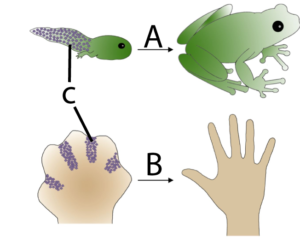
Apoptosis is programmed cell death. It’s a key part of development because it enables an organism to remove unnecessary cells and sculpt its emerging form. The breakdown of apoptosis (as discussed several times above) is an important element in cancer.
In the diagram on the left, you can see how apoptosis (C) in a tadpole’s tail (A) leads to the removal of that structure, something which also happens to human beings during our embryonic development. In B, you can see how at one point during development, our hand is a webbed paddle. Apoptosis is how the cells between the fingers are removed, allowing for the formation of distinct digits.
 Apoptosis is different from necrosis, which is a form of traumatic cell death that occurs when cells are injured. By contrast, apoptosis is highly regulated and controlled. It starts with the cell shrinking, and its nuclear material (called chromatin) condensing (shown in “b”). This is followed by DNA fragmentation and “blebbing:” protrusion of the membrane as the membrane uncouples from the cytoskeleton and the internal structure of the cell starts to disintegrate (in “c”). Finally, the cell breaks apart, becoming membrane-bound apoptotic bodies, which are consumed by cells of the immune system
Apoptosis is different from necrosis, which is a form of traumatic cell death that occurs when cells are injured. By contrast, apoptosis is highly regulated and controlled. It starts with the cell shrinking, and its nuclear material (called chromatin) condensing (shown in “b”). This is followed by DNA fragmentation and “blebbing:” protrusion of the membrane as the membrane uncouples from the cytoskeleton and the internal structure of the cell starts to disintegrate (in “c”). Finally, the cell breaks apart, becoming membrane-bound apoptotic bodies, which are consumed by cells of the immune system
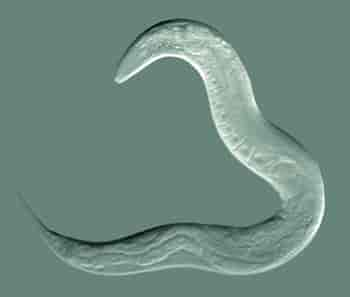
Apoptosis has been extensively studied in a roundworm called C. elegans. This tiny worm (about 1 mm) is one of the most studied organisms in biological science. It’s the source of much of our understanding of how multicellular organisms develop.
C elegans, as an adult, has exactly 959 cells. In the course of the cell divisions that produce these 959 cells, there are 131 instances of apoptosis. These are initiated by external signals. Here’s how the process works.
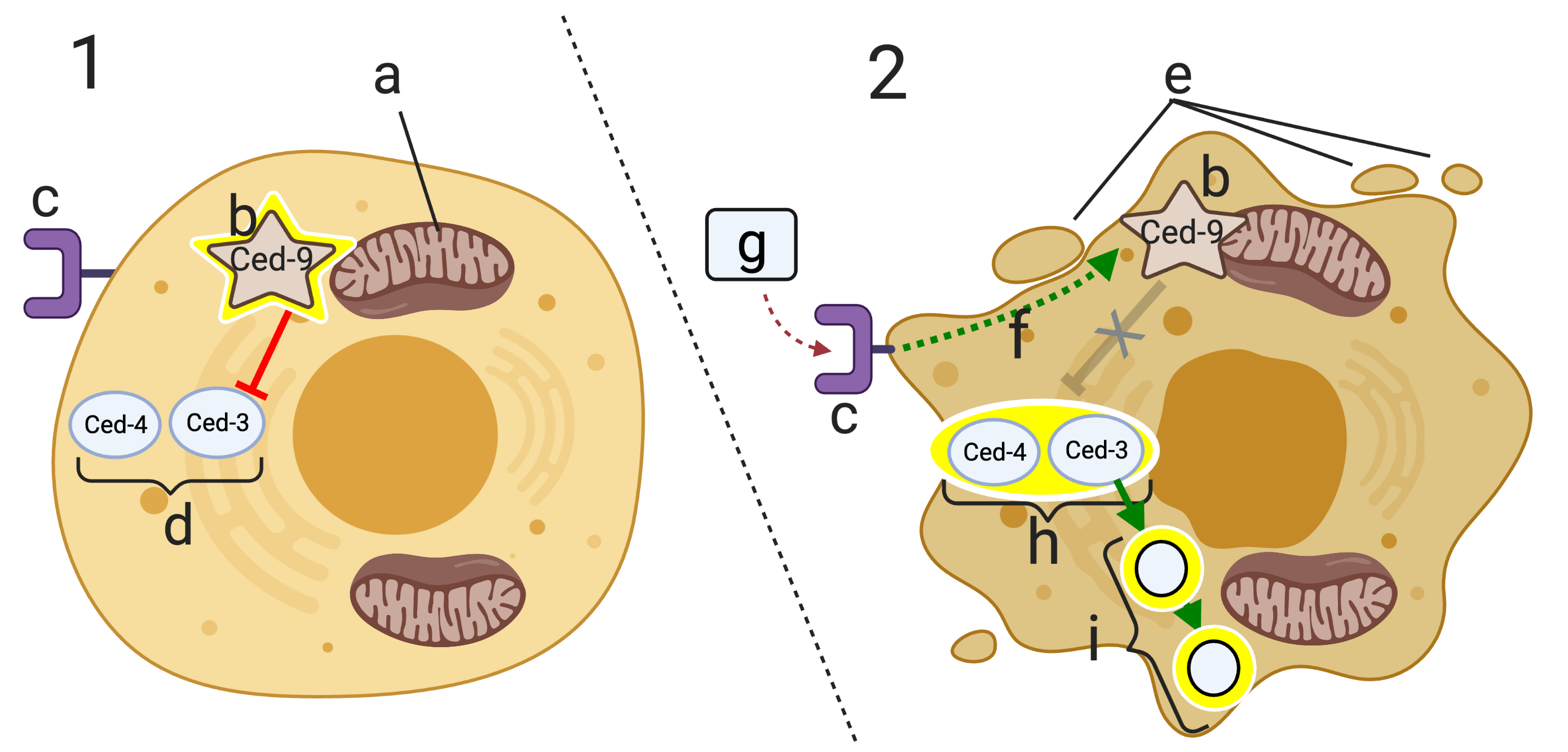
C. elegans has two key apoptosis genes, ced-4 and ced-3. “Ced” stands for cell death. These two genes code for two proteins, Ced-4 and Ced-3.
In cell “1,” these two proteins (at “d”) are inactive. They’re inactive because of a regulatory protein called Ced-9 (indicated by the glowing star at “b”). Ced-9 is bound to the mitochondrial membrane (“a”), and its effect on Ced-4 and Ced-3 is inhibitory (indicated by the red line with the bar).
If during development, a death signal (“g”) binds with the death signal receptor (at “c”), then a signal transduction cascade (f) alters the structure of Ced-9 so that it no longer inhibits Ced-4 and Ced-3. These proteins, in turn, become activated. This results in further signaling that activates enzymes that break down nucleic acids and proteins (indicated by “i”), which results in apoptosis.
Letter “e” in diagram 2 shows the initiation of the blebbing that characterizes apoptosis.
What’s shown above is called the extrinsic apoptotic pathway, because it’s initiated by a death signal from outside the cell. The intrinsic apoptotic pathway is generated from within the cell and can be initiated when a cell has suffered irreparable damage to its DNA, or when excessive protein misfolding has occurred.
8. Checking Understanding: Apoptosis
[qwiz random = “true” style=”width: 600px !important;” qrecord_id=”sciencemusicvideosMeister1961-Apoptosis (v2.0)” dataset=”Apoptosis”]
[h]Quiz: Apoptosis
[i]
[q json=”true” dataset_id=”Apoptosis|e3b4f59decbd3″ question_number=”1″]The image below is showing the importance of [hangman] in development.
[c]YXBvcHRvc2lz[Qq]
[q json=”true” dataset_id=”Apoptosis|e3b43b5a357d3″ question_number=”2″] In the diagram below, blebbing is shown at
[textentry single_char=”true”]
[c]IG M=[Qq]
[f]IE5pY2Ugd29yay4gQXMgdGhlIGNlbGwmIzgyMTc7cyBjeXRvc2tlbGV0b24gZGlzaW50ZWdyYXRlcywgbWVtYnJhbmUgcHJvdHJ1c2lvbnMgY2FsbGVkICYjODIyMDtibGVicyYjODIyMTsgZm9ybS4=[Qq]
[c]ICo=[Qq]
[f]IE5vLiBIZXJlJiM4MjE3O3MgYSBoaW50LiAmIzgyMjA7QmxlYnMmIzgyMjE7IGFyZSBwcm90cnVzaW9ucyBvZiB0aGUgbWVtYnJhbmUgZm9ybWVkIGFzIHRoZSBjeXRvc2tlbGV0b24gZGlzaW50ZWdyYXRlcy4=[Qq]
[q json=”true” dataset_id=”Apoptosis|e3b3a6573c7d3″ question_number=”3″]The cell below is undergoing [hangman]
[c]YXBvcHRvc2lz[Qq]
[q json=”true” dataset_id=”Apoptosis|e3b2ec13853d3″ question_number=”4″] In the diagram below, an external death signal is shown at
[textentry single_char=”true”]
[c]IG c=[Qq]
[f]IE5pY2Ugd29yay4gTGV0dGVyICYjODIyMDtnJiM4MjIxOyBpcyB0aGUgZXh0ZXJuYWwgZGVhdGggc2lnbmFsIHRoYXQgaW5kdWNlcyBhcG9wdG9zaXMu[Qq]
[c]ICo=[Qq]
[f]IE5vLiBGaW5kIHdoYXQgbG9va3MgbGlrZSBhbiBleHRlcm5hbCBzaWduYWwgdGhhdCB3b3VsZCBpbmR1Y2UgYXBvcHRvc2lzLg==[Qq]
[q json=”true” dataset_id=”Apoptosis|e3b231cfcdfd3″ question_number=”5″] In the diagram below, a death signal receptor is shown at
[textentry single_char=”true”]
[c]IG M=[Qq]
[f]IE5pY2Ugd29yay4gTGV0dGVyICYjODIyMDtjJiM4MjIxOyBpcyB0aGUgZGVhdGggc2lnbmFsIHJlY2VwdG9yLg==[Qq]
[c]ICo=[Qq]
[f]IE5vLiBGaW5kIHNvbWV0aGluZyBpbiB0aGUgbWVtYnJhbmUgdGhhdCBjb3VsZCByZWNlaXZlIGEgc2lnbmFsIHRoYXQgd291bGQgaW5kdWNlIGFwb3B0b3Npcy4=[Qq]
[q json=”true” dataset_id=”Apoptosis|e3b1524b587d3″ question_number=”6″] In the diagram below, the Ced-9 protein is at
[textentry single_char=”true”]
[c]IG I=[Qq]
[f]IE5pY2Ugd29yay4gTGV0dGVyICYjODIyMDtiJiM4MjIxOyBpcyB0aGUgQ2VkLTkgcHJvdGVpbi4=[Qq]
[c]ICo=[Qq]
[f]IE5vLiBUaGUgQ2VkLTkgcHJvdGVpbiBpcyBhdHRhY2hlZCB0byB0aGUgbWl0b2Nob25kcmlvbi4=[Qq]
[q json=”true” multiple_choice=”true” dataset_id=”Apoptosis|e3b072c6e2fd3″ question_number=”7″] In the diagram below, which statement best reflects the role of the Ced-9 protein?
[c]IFRoZSBDZWQtOSBwcm90ZWluIHNlbmRzIHNpZ25hbHMgdG8gQ2VkLTQgYW5kIENlZC0zIHRlbGxpbmcgdGhlbSB0byBpbml0aWF0ZSBhcG9wdG9zaXMu[Qq]
[f]IE5vLiBOb3RpY2UgaW4gZGlhZ3JhbSAxIHRoYXQgQ2VkLTkgaXMgc2lnbmFsaW5nIENlZC00IGFuZCBDZWQtMywgYnV0IHRoYXQgdGhleSYjODIxNztyZSA=Tk9UIGluaXRpYXRpbmcgYXBvcHRvc2lzLg==[Qq]
[c]IFRoZSBDZWQtOSBwcm90ZWluIHNlbmRzIGluaGliaXRvcnkgc2lnbmFscyB0byBDZWQt NCBhbmQgQ2VkLTMsIHByZXZlbnRpbmcgYXBvcHRvc2lzIGZyb20gb2NjdXJyaW5nLg==[Qq]
[f]IFRoYXQmIzgyMTc7cyBjb3JyZWN0LiBBcyB5b3UgY2FuIHNlZSBpbiBkaWFncmFtIDEsIHRoZSBtZXNzYWdlcyBzZW50IGZyb20gQ2VkLTkgdG8gQ2VkLTQgYW5kIENlZC0zIGFyZSA=aW5oaWJpdG9yeSwgcHJldmVudGluZyBhcG9wdG9zaXMgZnJvbSBvY2N1cnJpbmcu[Qq]
[c]IFRoZSBDZWQtOSBwcm90ZWluIGFzc2lzdHMgdGhlIGVudHJ5IG9mIHB5cnV2aWMgYWNpZCBpbnRvIHRoZSBtaXRvY2hvbmRyaW9uIGR1cmluZyB0aGUgbGluayByZWFjdGlvbi4=[Qq]
[f]IE5vLiBOb3RpY2UgdGhhdCBDZWQtOSBzZWVtcyB0byBiZSBzZW5kaW5nIGEgc2lnbmFsIHRvIENlZC00IGFuZCBDZWQtMywgYnV0IHRoYXQgdGhlc2UgY2VsbCBkZWF0aCBwcm90ZWlucyBhcmUgbm90IGluaXRpYXRpbmcgYXBvcHRvc2lzLg==[Qq]
[x][restart]
[/qwiz]
9. A Multistep Model of Cancer
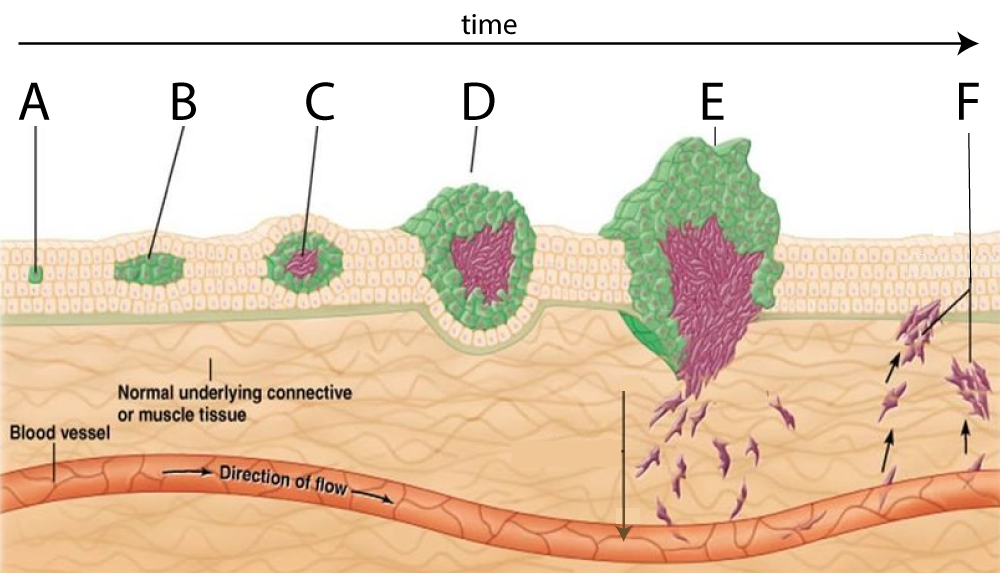
Cancer develops from just one cell. But multiple mutations over multiple generations are required for the descendants of that cell to develop into cancer.
This is known as the multi-step model of cancer. In the image on the left, “A” shows a cell that’s acquired a mutation, perhaps in a single tumor suppressor gene. A second tumor suppressor gene would remove the brakes on cell division, resulting in the growth at “B.” In steps “C” and “D” additional mutations, perhaps in the RAS gene, have increased the rate of growth. In step “E” additional mutations have enabled the cells to leave their site of origin and enter the bloodstream. In “F,” these cells are now creating new malignant tumors throughout the body.
10. Cancer and Apoptosis: Cumulative Flashcards
Use the flashcards below to consolidate your understanding of cancer and apoptosis.
[qdeck style=”width: 550px !important; min-height: 420px !important; ” bold_text=”false” scroll=”true” qrecord_id=”sciencemusicvideosMeister1961-Cancer and Apoptosis F.C (v2.0)” dataset=”Cancer and Apoptosis Flashcards”]
[h] Cancer and Apoptosis Cumulative Flashcards
[i]
[start]
[q json=”true” dataset_id=”Cancer and Apoptosis Flashcards|e3a976a336fd3″ question_number=”1″] What is cancer? On the most general level, what’s the connection between cancer and the cell cycle?
[a] Cancer is a disease involving uncontrolled cell growth. Cancer comes about when cells acquire mutations that increase their rate of replication. Rather than moving through the cell cycle at appropriate times (usually in response to growth signals from surrounding cells) cancer cells start to divide on their own, ultimately disrupting the tissues where they grow.
[q json=”true” dataset_id=”Cancer and Apoptosis Flashcards|e3a8bc5f7fbd3″ question_number=”2″] Define the following cancer-related terms:
- tumor
- benign
- metastasis
- malignant
[a]
- Tumor: an unorganized mass of cells.
- Benign tumor: a tumor that remains at its site of origin (without spreading to other tissues and parts of the body).
- Metastasis: the process by which the cells in a tumor spread to other parts of the body and establish new tumors.
- Malignant tumor: A tumor with cells that are metastasizing and spreading throughout the body and establishing new tumors.
Note: only click “Got it!” if you’ve mastered all four terms.
[q json=”true” dataset_id=”Cancer and Apoptosis Flashcards|e3a8021bc87d3″ question_number=”3″] Describe the two features of cancer that are represented in the image below.
[a]
1. Self-signaling to initiate the cell cycle (as opposed to requiring growth signals from the outside).
2. Ignoring apoptosis signals.
[q json=”true” dataset_id=”Cancer and Apoptosis Flashcards|e3a68d9459fd3″ question_number=”4″] Describe features 3 and 4 of cancer as represented in the image below.
[a]
3. Cell immortality. Cancer cells can continue to divide indefinitely, unlike normal cells which are limited to between 20 and 50 cell division cycles.
4. Ignoring signals to stop dividing.
[q json=”true” dataset_id=”Cancer and Apoptosis Flashcards|e3a5d350a2bd3″ question_number=”5″] Describe features 5 and 6 of cancer as represented in the image below.
[a]
5. Metastasis: Cancer cells can leave their site of origin and establish new tumors elsewhere in the body.
6. Angiogenesis: Cancerous tumors can send out signals that induce nearby blood vessels to grow into them and provide them with oxygen, nutrients, etc.
[q json=”true” dataset_id=”Cancer and Apoptosis Flashcards|e3a5190ceb7d3″ question_number=”6″] Describe and define the two types of genes associated with cancer
[a]
- Oncogenes are mutated genes that produce proteins that promote cell division in a cell, even when it’s not needed by the surrounding tissue.
- Tumor suppressor genes code for proteins that halt the cell cycle, or induce apoptosis.
[q json=”true” dataset_id=”Cancer and Apoptosis Flashcards|e3a45ec9343d3″ question_number=”7″] Describe the accelerator/brake pedal analogy for cancer.
[a] Normal cells have tumor suppressor genes that produce tumor suppressor proteins which can “put the brakes” on cell division (represented by A) or induce apoptosis. Cancer cells have mutations in which tumor suppressor genes have mutated so that the proteins they code for no longer function, and the cell cycle continues inappropriately. This is equivalent to the broken brake pedal at “C.”
In normal cells, proto-oncogenes promote cell division, but only in appropriate circumstances. That’s akin to a car’s accelerator moving a car forward as needed. In cancer cells, the accelerator is jammed so that it moves the car forward inappropriately. This is analogous to an oncogene, which constantly signals for the cell to divide.
[q json=”true” dataset_id=”Cancer and Apoptosis Flashcards|e3a35a04007d3″ question_number=”8″] Using the diagram below, describe how a mutation in the RAS proto-oncogene can induce a cell to become cancerous.
[a]
RAS (C) is a G protein. As a proto-oncogene (Image I), RAS only becomes active when an outside growth-factor ligand (A) binds with RAS’s coupled receptor (B). This causes RAS to bind with GTP (D), enabling it to initiate a signaling cascade (E) that results in a transcription factor that results in a protein (I) that promotes cell division (J)
When RAS mutates into an oncogene (Image II), it becomes constitutively active. In this condition (K), RAS can bind with GTP even in the absence of a growth signal (notice the unbound receptor at “J”). Because RAS is always active, the molecule that results in cell division (L) is overproduced, resulting in too much cell division.
[q json=”true” dataset_id=”Cancer and Apoptosis Flashcards|e3a27a7f8afd3″ question_number=”9″] Using the image below, explain how mutations in a tumor suppressor gene such as the p53 gene can contribute to cancer.
[a]
p53 is a tumor suppressor gene. When it’s working, it functions as shown in Image 1. When cells experience DNA damage (A), a signaling cascade (B) activates p53. If the DNA can be repaired, p53 will halt the cell cycle (1) while DNA repair enzymes fix the damage (2). If the damage is too great, p53 will signal the cell to initiate apoptosis.
If mutations lead p53 to become non-functional (C in Image 2) then the cell will continue to divide, even with damaged DNA (A). That will increase the chance of the cell acquiring further mutations that can lead it to become cancerous.
[q json=”true” dataset_id=”Cancer and Apoptosis Flashcards|e3a175ba573d3″ question_number=”10″] The diagram below presents a situation that’s associated with a high percentage of breast cancers. Explain.
[a] In diagram A, the cell has a normal number of receptors for a growth factor that leads to cell division, leading to a normal rate of cell division. In diagram C, the cell has a mutation that’s causing it to overexpress the growth factor receptor. With too many receptors, the cell is oversensitized to the growth factor and reproduces even when the amount of growth factor in the cell’s environment is too low. The result: too much cell division (as shown in “D”).
[q json=”true” dataset_id=”Cancer and Apoptosis Flashcards|e3a070f5237d3″ question_number=”11″] Define apoptosis. Why is it important in normal cell growth? Why is it relevant to understanding cancer?
[a] Apoptosis is programmed cell death. It plays a key role in normal body development, enabling a developing organism to eliminate unnecessary cells and sculpt the body’s emerging form. Apoptosis is relevant to cancer because cancer cells often have mutations that allow them to ignore apoptosis signals.
[q json=”true” dataset_id=”Cancer and Apoptosis Flashcards|e39bc8dd5b7d3″ question_number=”12″] Using the image below, describe a signaling pathway that leads to apoptosis.
[a]
In cells that are not undergoing apoptosis, the cell death proteins Ced-4 and Ced-3 are inactive. They’re inactive because they receive inhibitory signals from another cell death protein (Ced-9, shown at “b,” attached to the mitochondria). When a cell receives an external death signal (“g”), a signaling pathway (f) leads to the inactivation of Ced-9 (“b”). Once deactivated, Ced-9 stops sending inhibitory signals to Ced-4 and Ced-3. No longer inhibited, these proteins initiate a cell-death pathway (“i”) that produces enzymes that destroy the cell’s proteins and nucleic acids. Ultimately, the cell starts to bleb (“e”). Once destroyed, the fragments will be consumed and recycled by the immune system.
[x] [restart]
[/qdeck]
11. What’s Next?
Wrap up what you’ve learned in AP Bio Unit 4 with these Unit 4 Cumulative Flashcards and Quizzes.
